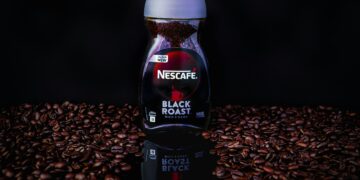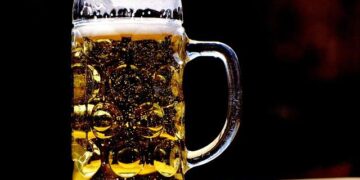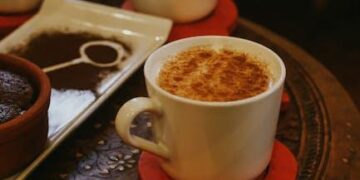Table of Contents
Part 1: The Bitter Betrayal: My Descent into the Decaf Wasteland
The ritual was my anchor.
Every morning, the gentle whir of the burr grinder, the precise weight of single-origin beans on the scale, the careful pour-over that coaxed notes of cherry and dark chocolate from a fresh roast.
Coffee wasn’t just a beverage; it was a craft, a moment of quiet contemplation that kickstarted my day.
Then came the doctor’s visit, and the verdict was handed down like a life sentence: no more caffeine.
My first forays into the world of decaf were a study in disappointment.
I started with the supermarket brands, naively hoping for a seamless transition.
The coffee brewed, it smelled vaguely like coffee, but the first sip was a betrayal.
It was thin, strangely sour, and hollow, a ghost of the drink I loved.1
I tried cafes, hoping the professionals had cracked the code.
The result was the same.
Forum posts online confirmed I wasn’t alone in this purgatory.
My experience was a universal one, echoed in cries of “most seem to taste terrible” and descriptions of beans that were “sour as hell”.2
The consensus was clear: decaf had a “dull, more muted taste” that felt like a pale imitation of the real thing.1
The problem intensified when summer arrived and my craving for cold coffee began.
My standard method—brewing a pot of hot decaf and chilling it over ice—was a disaster.
The heat of the brewing process seemed to amplify all of decaf’s worst qualities.
The resulting “iced coffee” was an acidic, watery mess that was utterly undrinkable.4
I remember one particularly bleak afternoon, staring into a glass of brownish liquid, feeling utterly defeated.
I was on the verge of giving up, resigning myself to a life without the simple joy of a good cup of coffee.6
It was then I realized the problem ran deeper than just bad taste.
The frustration wasn’t just about a disappointing beverage; it was about the loss of a deeply ingrained, psychologically comforting ritual.
That morning cup was a sensory anchor, a moment of creative peace that set the tone for the entire day.7
Even without the chemical kick of caffeine, the ritual itself can provide a powerful placebo effect of focus and comfort.8
Bad decaf didn’t just taste bad; it actively sabotaged this ritual, replacing pleasure with a consistent, nagging sense of loss.
The gap between my expectation—the memory of rich, complex coffee—and the sour reality in my cup was where the feeling of betrayal lived.
To fix the coffee, I first had to understand why it was so broken.
Part 2: Anatomy of a Flavor Heist: The Science Behind Bad Decaf
My quest for a decent cup of decaf turned into a full-blown investigation.
I discovered that the problem wasn’t a single issue, but a cascade of compromises and chemical realities.
The poor taste of most decaf isn’t an accident; it’s the predictable result of economics and chemistry.
Sub-section 2.1: The Unspoken Compromise – Economics and Bean Quality
The first culprit is simple economics.
Decaffeination is an additional, complex, and expensive processing step.6
To keep the final price of a bag of decaf competitive with its caffeinated counterpart, many large-scale producers start with a lower-quality raw material: cheaper green coffee beans.6
This creates a classic “garbage in, garbage out” scenario.
Even the most sophisticated decaffeination process cannot magically create a complex, delicious flavor profile from inferior beans.
This economic pressure creates a vicious cycle.
Roasters use cheaper beans to offset costs, resulting in a bad-tasting product.
Consumers try this bad decaf, which confirms their low expectations and reinforces their unwillingness to pay a premium for a better version.6
This cycle traps much of the mainstream decaf market in a state of perpetual mediocrity.
Breaking the cycle requires a conscious choice to step outside of it and understand what separates a premium decaf from the rest.
Sub-section 2.2: The Decaffeination Gauntlet: A Tour of the Four Main Processes
A coffee bean is a complex chemical marvel, containing around 1,000 different compounds that contribute to its unique taste and aroma.11
The challenge of decaffeination is to surgically remove just one of those compounds—caffeine—while leaving the other 999 untouched.
This is the gauntlet every decaf bean must run, and the method used has a profound impact on the final flavor.
- Direct-Solvent Process: In this common method, green coffee beans are steamed to open their pores and then repeatedly washed with a chemical solvent, typically methylene chloride or ethyl acetate, which binds to and removes the caffeine.9 While regulatory bodies deem the trace amounts left after roasting to be safe, this process can be harsh on the delicate flavor compounds, often stripping them away and contributing to the “off” taste many people associate with decaf.8
- Indirect-Solvent Process: This method avoids direct contact between the beans and the solvent. The beans are first soaked in hot water, which absorbs the caffeine and flavor compounds. This water is then transferred to a separate tank where it’s treated with a solvent to remove the caffeine. Finally, the now caffeine-free, flavor-laden water is returned to the beans so they can reabsorb their original flavors.9 However, this process of stripping and reabsorbing is imperfect, and significant flavor loss can still occur.14
- CO2 Process: This more modern method uses supercritical carbon dioxide (CO2) as a highly selective solvent. Under high pressure, the liquid CO2 bonds with and removes the caffeine molecules while leaving most of the larger flavor compounds intact.9 It’s a much gentler and more effective process but is also more expensive, often limiting its use to large-scale commercial operations.13
- Water Process (The Gold Standard): Methods like the renowned Swiss Water Process and Mountain Water Process represent the pinnacle of quality decaffeination. These processes are entirely chemical-free.15 They begin by creating a “Green Coffee Extract” (GCE) by soaking an initial batch of beans in hot water. This water, now saturated with all of coffee’s soluble compounds, is passed through a carbon filter that captures only the caffeine molecules.11 The result is a solution rich in coffee flavor, but with no caffeine. A fresh batch of green coffee beans is then soaked in this GCE. Because the water is already saturated with flavor molecules, a state of equilibrium is reached where only the caffeine leaches out of the new beans, leaving their original flavor profile almost entirely intact. This ingenious use of osmosis and solubility is why water-processed decafs are prized in the specialty coffee world for their superior flavor preservation.10
Sub-section 2.3: The Missing Molecules – Why Decaf Tastes “Hollow”
The most profound revelation in my research came from a scientific study that pinpointed exactly what gets lost in translation.
The decaffeination process, even a gentle one, can inadvertently remove or reduce crucial “aroma precursors”—the building blocks of flavor that are developed during roasting.16
A 2022 study published in Foods used advanced gas chromatography to analyze the volatile compounds in regular versus decaffeinated coffee.
The results were stunning.
They found that a group of compounds called pyrazines were significantly less abundant in decaffeinated coffee.16
Why does this matter? Because pyrazines are responsible for some of the most beloved and defining aromas in coffee:
nutty, roasted, chocolate, and earthy notes.16
The loss of these specific molecules is the scientific explanation for that “hollow,” “plain,” or “thin” taste that plagues so many decaf coffees.
It’s not just a vague sense of something being wrong; it’s the quantifiable absence of the very compounds that our brains register as “coffee.” This was the key.
The flavor hadn’t just been damaged; it had been deconstructed.
Part 3: The Epiphany: Stop Trying to Brew Decaf. Start Rebuilding It.
After countless failed cups and hours of research, I had my moment of clarity.
I had been approaching the problem all wrong.
I was trying to use standard brewing methods—methods designed for a complete, unaltered ingredient—on a bean that was fundamentally changed.
The decaffeination process doesn’t just remove caffeine; it disassembles the bean on a molecular level.
This led me to my central analogy: rebuilding a high-performance engine.
A regular, high-quality coffee bean is like a fully assembled, factory-tuned engine, ready to perform.
A decaf bean is like that same engine, but it has been carefully taken apart to remove one tiny component (caffeine).
In the process, some other crucial gaskets and bolts (the pyrazines and other flavor compounds) were inevitably lost or damaged.
You can’t just turn the key on this disassembled engine and expect it to roar to life.
It will sputter, cough, and run poorly.
My epiphany was that my job as a home brewer was no longer to be a simple driver.
I had to become a master mechanic.
My task was to take this high-potential but disassembled engine and carefully rebuild it.
This meant starting with the highest-quality parts I could find (the best beans), using a specific assembly process (the cold brew method) designed to compensate for the missing pieces, and tuning it to perfection (with precise ratios and time).
This reframed the entire endeavor.
It wasn’t a chore anymore; it was a craft.
And I was going to master it.
Part 4: The Decaf Cold Brew Blueprint: A Masterclass in Rebuilding Flavor
Armed with this new mindset, I developed a three-part blueprint for rebuilding flavor and creating a flawless cup of decaf cold brew.
This isn’t just a recipe; it’s a complete system designed to overcome every one of decaf’s inherent challenges.
Sub-section 4.1: Sourcing Your Engine Block – An Uncompromising Guide to Decaf Beans
You cannot build a great engine from subpar parts.
Sourcing the right beans is the most critical step, and it’s governed by three non-negotiable commandments.
- The First Commandment: Process is Everything. This is the single most important factor. You must actively seek out beans that have been decaffeinated using a Swiss Water Process, Mountain Water Process, or a similar high-quality, chemical-free water process. These methods are specifically designed for maximum flavor preservation.10 Roasters who use these superior methods are proud of it and will almost always state it clearly on the bag or their website. If it doesn’t say, assume it’s a solvent-based process and move on.
- The Second Commandment: Quality In, Quality Out. Look for specialty coffee roasters who treat decaf as a first-class citizen, not an afterthought. These are the roasters who use high-quality, often single-origin, beans before the decaffeination process even begins.6 They provide details about the bean’s origin, tasting notes, and processing, signaling a commitment to quality.
- The Third Commandment: Roast and Freshness. For cold brew, a medium to dark roast is generally preferable. The longer, gentler extraction of cold brewing excels at pulling out the rich, full-bodied, chocolatey, and nutty notes characteristic of these roasts, which helps to rebuild the flavor profile that decaffeination can diminish.5 Finally, always buy
freshly roasted whole beans and grind them yourself immediately before brewing. Decaf beans are already fragile; pre-grinding them exposes more surface area to oxygen, causing the few remaining volatile aromatic compounds to dissipate rapidly.8
To save you the frustrating and expensive trial-and-error, here is a field guide to some of the best, most reliable decaf beans on the market that meet these criteria.
| Brand & Blend Name | Decaffeination Process | Roast Level | Origin(s) | Official Tasting Notes & Expert Impressions |
| Counter Culture Slow Motion | Swiss Water Process | Medium | Latin America | Official notes: “Molasses and cocoa.” Testers find bright stone fruit, exceptional sweetness, and balance. A complex coffee that doesn’t taste like decaf.17 |
| Stumptown Trapper Creek | Swiss Water Process | Medium | Varies | Official notes: “Cherry and milk chocolate.” Consistently praised for its unique, strong flavor and impressive balance.6 |
| Jo Coffee No Fun Jo Decaf | Swiss Water Process | Dark | Varies | A smooth dark roast without bitterness. Notes of berries and rich chocolate make it an excellent choice.17 |
| Kicking Horse Decaf | Swiss Water Process | Dark | Central & South America | A rich and robust profile with notes of roasted hazelnut and chocolate. A fantastic budget-friendly option without compromise.17 |
| Stone Street Cold Brew Decaf | Swiss Water Process | Medium | Mexico | Specifically formulated for cold brew. Praised for its balanced, bold flavor, slight sweetness, and low acidity.18 |
| Peet’s Coffee Decaf Big Bang | Water Process | Medium (presents dark) | Latin America | For those who enjoy a darker profile, this offers a smoky, full-bodied cup with a deep, satisfying sweetness.21 |
Sub-section 4.2: The Architect’s Toolkit – Mastering Grind, Ratio, and Time
With your high-quality beans in hand, the next step is to use the right tools and measurements to assemble your brew.
- Grind Size: Coarse is Your Friend. For any immersion brewing method, and especially for cold brew, a coarse grind is essential. The grounds should resemble the texture of coarse sea salt or breadcrumbs.5 This large particle size prevents over-extraction during the long steep, which would lead to bitterness, and it makes the final filtering process much cleaner and easier.
- The Golden Ratio for Concentrate: The goal is to create a coffee concentrate, which gives you maximum flavor and the flexibility to dilute it to your exact preference. After synthesizing dozens of recommendations, the ideal starting point is a 1:8 ratio by weight (e.g., 1 gram of coffee for every 8 grams of water).23 This creates a strong, smooth, and versatile concentrate. For those who want to experiment, a 1:4 ratio produces an extremely potent “rocket fuel,” while a 1:12 ratio can create a brew that’s ready to drink without dilution.24
- Time: The Magic Ingredient. Cold brew substitutes time for heat. The ideal steeping window is between 12 and 18 hours at room temperature or in the refrigerator.19 Steeping for less than 12 hours can result in a weak, underdeveloped flavor. Pushing past 24 hours risks extracting bitter, woody notes. My personal sweet spot for rich, smooth flavor is right around 18 hours.
Sub-section 4.3: The Cold Infusion – A Step-by-Step Guide to Flawless Decaf Cold Brew
This is the assembly process.
You don’t need fancy equipment; a large Mason jar and a simple filter are all it takes to achieve perfection.19
- Measure and Grind: Using a kitchen scale, weigh out your high-quality whole bean decaf coffee. For a 1-liter batch, a good starting point is 125 grams. Grind the beans to a coarse consistency.
- Combine and Saturate: Place the grounds in your large jar or French press. Place the jar on the scale, zero it out, and slowly pour in the corresponding amount of cold, filtered water (1000 grams, or 1 liter, for a 1:8 ratio). Stir gently but thoroughly with a long spoon to ensure all the coffee grounds are fully saturated. There should be no dry clumps.27
- Steep: Cover the container and let it steep. You can leave it on your countertop at room temperature or place it in the refrigerator for 12 to 18 hours.
- Strain: This is a critical step for a clean, grit-free cup. If using a French press, simply press the plunger down slowly and firmly. If using a jar, pour the mixture through a fine-mesh sieve lined with a layer of cheesecloth or a standard paper coffee filter set over a clean pitcher or bowl.4 Be patient and let it drip; don’t squeeze the filter, as that can introduce bitterness.
- Dilute and Serve: What you have now is a rich coffee concentrate. The classic way to serve it is by diluting it 1:1 with cold water or your milk of choice.23 Fill a glass with ice, pour in half a cup of concentrate, and top with half a cup of water. Give it a stir and taste. From here, you can adjust the dilution to achieve your perfect strength.
- Store: Pour your remaining concentrate into a sealed bottle or jar and store it in the refrigerator. It will stay fresh and delicious for up to two weeks, giving you instant access to perfect decaf cold brew every morning.19
Part 5: Advanced Engineering: Why Cold Brew is Decaf’s Savior
This blueprint works consistently because it is chemically and physically tailored to solve decaf’s core problems.
It’s not just a different way of making coffee; it’s a better way, especially for this unique challenge.
Sub-section 5.1: The Chemical Advantage – Cold Brew vs. Iced Coffee
The fundamental difference between cold brew and standard iced coffee is the role of heat.
This distinction is the secret to redeeming decaf.
- Iced Coffee: This is simply hot-brewed coffee that has been cooled down, usually by pouring it over ice.4 The high temperature of hot brewing is very efficient at extraction, but it aggressively pulls out acids and oils from the bean. When this brew cools, these compounds can create a harsh, bitter, and sour taste.29 For a fragile decaf bean already prone to sourness, this thermal shock is a recipe for disaster.
- Cold Brew: This method uses a slow, gentle infusion with cold or room-temperature water. By replacing heat with time, the extraction process is fundamentally different. Scientific analysis shows that cold brew is significantly less acidic—by some estimates, 60-70% less acidic—than its hot-brewed counterpart.4 It extracts fewer of the bitter-tasting compounds, resulting in a brew that is naturally smoother, rounder, and sweeter.19
This low-acid, smooth, and sweet flavor profile is the perfect chemical antidote to decaf’s inherent weaknesses.
Cold brewing doesn’t just extract flavor; it selectively extracts the right flavors, leaving the undesirable acidic and bitter compounds behind.
It rebuilds the taste profile by focusing on the deep, sweet notes that survive the decaffeination process, rather than highlighting the sourness that hot brewing can amplify.
Sub-section 5.2: The “Double Jeopardy” of Decaf – Pro-Level Brewing Adjustments
The final layer of expert knowledge lies in understanding that decaf beans are not just chemically altered, but physically altered as well.
The decaffeination process strips oils and changes the cellular structure of the bean, making it more porous and less dense than a regular bean.8
This physical change makes decaf beans more sensitive during both roasting and brewing.
Roasters must apply heat more gently to avoid scorching them.2
This creates a “Double Jeopardy” for the home brewer.
You start with a bean that has a compromised flavor potential (the chemical problem), and that same bean is also more physically fragile and prone to over-extraction (the physical problem).
This is why, counter-intuitively, many experts recommend reducing extraction when brewing decaf hot.
While you might think a “weaker” bean needs more aggressive brewing, the opposite is true.
Its fragility means it requires a gentler touch.
The cold brew method is the ultimate gentle touch, as it removes the variable of high heat entirely.
However, should you wish to attempt a hot pour-over with your high-quality decaf, remember this principle: treat it gently.
Use water that is just off the boil (around 195-205°F or 90-93°C), grind slightly coarser than you would for regular coffee, and use less agitation in your pouring technique to avoid over-extracting and creating bitterness.20
Part 6: The Morning Ritual, Reclaimed
I’ll never forget the first sip.
After letting my first batch of decaf cold brew concentrate steep for 18 hours, I strained it, poured it 1:1 with cold water over a tall glass of ice, and took a tentative drink.
It was a revelation.
It was smooth, impossibly so.
There was absolutely no sourness, no biting acidity.
Instead, there was a clear, deep, satisfying flavor of dark chocolate and a hint of molasses, the exact notes promised on the bag of Counter Culture Slow Motion beans.
It was full-bodied, rich, and complex.
It wasn’t just “good for decaf.” It was genuinely, objectively delicious coffee.
In that moment, it wasn’t just a beverage I had reclaimed; it was my entire morning ritual.
The disappointment was gone, replaced by a sense of pride and accomplishment.
Delicious decaf is not a myth or a lucky accident.
It is a science and a craft.
By understanding the reasons behind bad decaf—the economics, the chemistry, the physics—and by adopting a method designed to rebuild flavor from the ground up, anyone can escape the purgatory of bad coffee.
The journey from bitter betrayal to a perfect, satisfying cup is not only possible; it’s waiting for you in that first, flawless sip.
Works cited
- Decaf Vs Regular Coffee: Pros & Cons, accessed August 6, 2025, https://esquirescoffee.co.uk/news/decaf-vs-regular-coffee/
- Is it just me, or does decaf coffee taste different than regular coffee? – Reddit, accessed August 6, 2025, https://www.reddit.com/r/Coffee/comments/5e1rio/is_it_just_me_or_does_decaf_coffee_taste/
- Decaff coffee taste test – Request a Test – CHOICE Community, accessed August 6, 2025, https://choice.community/t/decaff-coffee-taste-test/21034
- Cold Brew vs. Iced Coffee: An Expert Explains the Difference – Simply Recipes, accessed August 6, 2025, https://www.simplyrecipes.com/cold-brew-vs-iced-coffee-expert-11740109
- What’s the Difference Between Cold Brew and Iced Coffee? – Food & Wine, accessed August 6, 2025, https://www.foodandwine.com/cold-brew-vs-iced-coffee-7567073
- Why doesn’t decaf taste as good as regular coffee and what can I do about it? – Reddit, accessed August 6, 2025, https://www.reddit.com/r/Coffee/comments/jq3paa/why_doesnt_decaf_taste_as_good_as_regular_coffee/
- Does decaf coffee taste different? | Cathe Friedrich Fitness Forums, accessed August 6, 2025, https://cathe.com/forum/threads/does-decaf-coffee-taste-different.225926/
- Why Does Decaf Coffee Taste Different, accessed August 6, 2025, https://www.darkhorsecoffeecompany.com/blogs/the-three-gs-blog-grit-grind-and-gratitude/why-does-decaf-coffee-taste-different
- How is decaf coffee made? And is it really caffeine-free? – School of Public Health, accessed August 6, 2025, https://public-health.uq.edu.au/article/2023/11/how-decaf-coffee-made-and-it-really-caffeine-free
- What’s The Truth About Decaffeinated Coffee? – Perfect Daily Grind, accessed August 6, 2025, https://perfectdailygrind.com/2018/11/whats-the-truth-about-decaffeinated-coffee/
- Decaffeination Processes Explained – Durango Coffee Company, accessed August 6, 2025, https://durangocoffee.com/decaffeination-processes/
- The Science Behind Decaffeination: How It Affects Flavor – Coffee Machines Sale, accessed August 6, 2025, https://cmsale.com/news/the-science-behind-decaffeination-how-it-affects-flavor
- Water Process Decaffeinated Coffee, accessed August 6, 2025, https://44northcoffee.com/pages/water-process-decaffeinated-coffee
- The Science Behind Decaf – McGill University, accessed August 6, 2025, https://www.mcgill.ca/oss/article/health-technology/science-behind-decaf
- Does Decaffeination Affect the Flavor of Whole Bean Decaf Coffee?, accessed August 6, 2025, https://frontiercoffeeroasters.com/blogs/frontier-coffee-roasters-blog/does-decaffeination-affect-the-flavor-of-whole-bean-decaf-coffee
- Distinguishing between Decaffeinated and Regular Coffee by HS-SPME-GC×GC-TOFMS, Chemometrics, and Machine Learning, accessed August 6, 2025, https://pmc.ncbi.nlm.nih.gov/articles/PMC8948847/
- The 8 Best Decaf Coffees of 2025, Tested … – The Spruce Eats, accessed August 6, 2025, https://www.thespruceeats.com/best-decaf-coffee-4771335
- Cold Brew Swiss Water Decaf – Stone Street Coffee Company, accessed August 6, 2025, https://stonestreetcoffee.com/products/cold-brew-decaf-blend
- A Decaf Cold Brew Guide | Coffee Bean Corral, accessed August 6, 2025, https://www.coffeebeancorral.com/blog/post/decaf-cold-brew
- How to Brew Strong Decaf Ground Coffee Without Losing Flavor, accessed August 6, 2025, https://frontiercoffeeroasters.com/blogs/frontier-coffee-roasters-blog/how-to-brew-strong-decaf-ground-coffee-without-losing-flavor
- The 4 Best Decaf Coffee of 2025, Tested & Reviewed – Serious Eats, accessed August 6, 2025, https://www.seriouseats.com/best-decaf-coffee-7547427
- Best Brewing Methods for Rich-Tasting Whole Bean Decaf Coffee, accessed August 6, 2025, https://frontiercoffeeroasters.com/blogs/frontier-coffee-roasters-blog/best-brewing-methods-for-rich-tasting-whole-bean-decaf-coffee
- counterculturecoffee.com, accessed August 6, 2025, https://counterculturecoffee.com/blogs/counter-culture-coffee/guide-to-cold-brew
- Cold Brew Coffee 101—Your Complete Guide to the Best Brew – CoffeeSock, accessed August 6, 2025, https://coffeesock.com/the-sock-life-1/2021/4/11/cold-brew-coffee-101your-complete-guide-to-the-best-brew
- The Ultimate Guide on Making Cold Brew Coffee Concentrate – Sunday Table, accessed August 6, 2025, https://sundaytable.co/cold-brew-coffee-concentrate/
- Cold Brew Coffee Ratio – A Guide – DripBeans, accessed August 6, 2025, https://dripbeans.com/cold-brew-coffee-ratio-a-guide/
- How to Cold Brew Decaf and Caffeinated Coffee, accessed August 6, 2025, https://kauaicoffee.com/blogs/guides/how-to-cold-brew-decaf-and-caffeinated-coffee
- Decaf Cold coffee drinks : r/Frugal – Reddit, accessed August 6, 2025, https://www.reddit.com/r/Frugal/comments/10cmwfv/decaf_cold_coffee_drinks/
- Make Your Own Cold Brew Decaf Coffee | Lisa’s Counter Culture, accessed August 6, 2025, https://lisascounterculture.com/make-your-own-cold-brew-decaf-coffee/
- Cold Brew vs Iced Coffee | Starbucks® Coffee At Home, accessed August 6, 2025, https://athome.starbucks.com/story/cold-brew-versus-iced-coffee
- New video: 5 tips for brewing better decaf filter coffee : r/pourover – Reddit, accessed August 6, 2025, https://www.reddit.com/r/pourover/comments/1apsk01/new_video_5_tips_for_brewing_better_decaf_filter/






